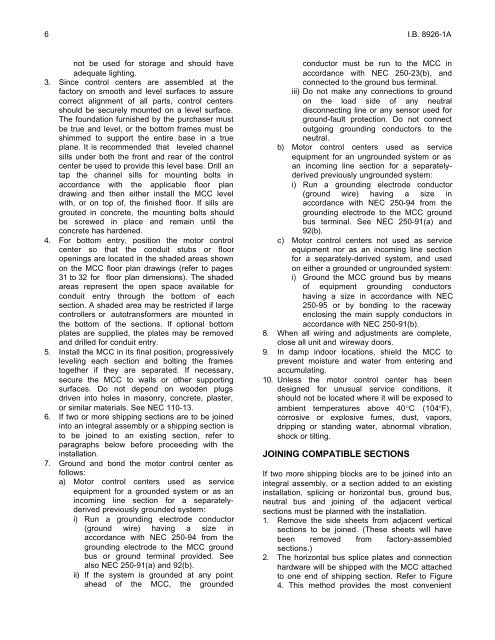Freedom 2100 Motor Control Center Installation - emsco
Freedom 2100 Motor Control Center Installation - emsco
Freedom 2100 Motor Control Center Installation - emsco
You also want an ePaper? Increase the reach of your titles
YUMPU automatically turns print PDFs into web optimized ePapers that Google loves.
6 I.B. 8926-1A<br />
not be used for storage and should have<br />
adequate lighting.<br />
3. Since control centers are assembled at the<br />
factory on smooth and level surfaces to assure<br />
correct alignment of all parts, control centers<br />
should be securely mounted on a level surface.<br />
The foundation furnished by the purchaser must<br />
be true and level, or the bottom frames must be<br />
shimmed to support the entire base in a true<br />
plane. It is recommended that leveled channel<br />
sills under both the front and rear of the control<br />
center be used to provide this level base. Drill an<br />
tap the channel sills for mounting bolts in<br />
accordance with the applicable floor plan<br />
drawing and then either install the MCC level<br />
with, or on top of, the finished floor. If sills are<br />
grouted in concrete, the mounting bolts should<br />
be screwed in place and remain until the<br />
concrete has hardened.<br />
4. For bottom entry, position the motor control<br />
center so that the conduit stubs or floor<br />
openings are located in the shaded areas shown<br />
on the MCC floor plan drawings (refer to pages<br />
31 to 32 for floor plan dimensions). The shaded<br />
areas represent the open space available for<br />
conduit entry through the bottom of each<br />
section. A shaded area may be restricted if large<br />
controllers or autotransformers are mounted in<br />
the bottom of the sections. If optional bottom<br />
plates are supplied, the plates may be removed<br />
and drilled for conduit entry.<br />
5. Install the MCC in its final position, progressively<br />
leveling each section and bolting the frames<br />
together if they are separated. If necessary,<br />
secure the MCC to walls or other supporting<br />
surfaces. Do not depend on wooden plugs<br />
driven into holes in masonry, concrete, plaster,<br />
or similar materials. See NEC 110-13.<br />
6. If two or more shipping sections are to be joined<br />
into an integral assembly or a shipping section is<br />
to be joined to an existing section, refer to<br />
paragraphs below before proceeding with the<br />
installation.<br />
7. Ground and bond the motor control center as<br />
follows:<br />
a) <strong>Motor</strong> control centers used as service<br />
equipment for a grounded system or as an<br />
incoming line section for a separatelyderived<br />
previously grounded system:<br />
i) Run a grounding electrode conductor<br />
(ground wire) having a size in<br />
accordance with NEC 250-94 from the<br />
grounding electrode to the MCC ground<br />
bus or ground terminal provided. See<br />
also NEC 250-91(a) and 92(b).<br />
ii) If the system is grounded at any point<br />
ahead of the MCC, the grounded<br />
conductor must be run to the MCC in<br />
accordance with NEC 250-23(b), and<br />
connected to the ground bus terminal.<br />
iii) Do not make any connections to ground<br />
on the load side of any neutral<br />
disconnecting line or any sensor used for<br />
ground-fault protection. Do not connect<br />
outgoing grounding conductors to the<br />
neutral.<br />
b) <strong>Motor</strong> control centers used as service<br />
equipment for an ungrounded system or as<br />
an incoming line section for a separatelyderived<br />
previously ungrounded system:<br />
i) Run a grounding electrode conductor<br />
(ground wire) having a size in<br />
accordance with NEC 250-94 from the<br />
grounding electrode to the MCC ground<br />
bus terminal. See NEC 250-91(a) and<br />
92(b).<br />
c) <strong>Motor</strong> control centers not used as service<br />
equipment nor as an incoming line section<br />
for a separately-derived system, and used<br />
on either a grounded or ungrounded system:<br />
i) Ground the MCC ground bus by means<br />
of equipment grounding conductors<br />
having a size in accordance with NEC<br />
250-95 or by bonding to the raceway<br />
enclosing the main supply conductors in<br />
accordance with NEC 250-91(b).<br />
8. When all wiring and adjustments are complete,<br />
close all unit and wireway doors.<br />
9. In damp indoor locations, shield the MCC to<br />
prevent moisture and water from entering and<br />
accumulating.<br />
10. Unless the motor control center has been<br />
designed for unusual service conditions, it<br />
should not be located where it will be exposed to<br />
ambient temperatures above 40°C (104°F),<br />
corrosive or explosive fumes, dust, vapors,<br />
dripping or standing water, abnormal vibration,<br />
shock or tilting.<br />
JOINING COMPATIBLE SECTIONS<br />
If two more shipping blocks are to be joined into an<br />
integral assembly, or a section added to an existing<br />
installation, splicing or horizontal bus, ground bus,<br />
neutral bus and joining of the adjacent vertical<br />
sections must be planned with the installation.<br />
1. Remove the side sheets from adjacent vertical<br />
sections to be joined. (These sheets will have<br />
been removed from factory-assembled<br />
sections.)<br />
2. The horizontal bus splice plates and connection<br />
hardware will be shipped with the MCC attached<br />
to one end of shipping section. Refer to Figure<br />
4. This method provides the most convenient


